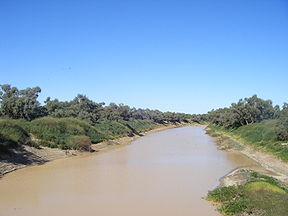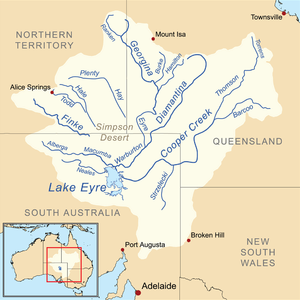- Diamantina River
-
Diamantina River
The Diamantina River at Birdsville, QueenslandOrigin Swords Range Mouth confluence with the Georgina River Basin countries Australia Length 900 km Basin area 157,000 km² The Diamantina River is a river in south west Queensland and the far north of South Australia. Rising north-west of Longreach in the Swords Range, it flows in a south-westerly direction through central Queensland and the Channel Country to form the Warburton River at its confluence with the Georgina River.[1][2] In extremely wet years, the Warburton River flows as far as Lake Eyre.[3] The length of the Diamantina River is approximately 900 km (560 mi), and the basin is approximately 157,000 km²,[4] of which most (140,000 km²) is used for agriculture.
The river was named by William Landsborough in 1866 for Lady Diamantina Bowen (née Roma), wife of Sir George Ferguson Bowen, the first Governor of Queensland.[5] It has three major tributaries the Western River, Mayne River and Farrars Creek.[6]
Most of the basin of the Diamantina is very flat—even the highest points in the northeast do not reach 500 m (1,600 ft) above sea level and Lake Eyre itself is 16 m (52 ft) below sea level. Apart from a few streams near Winton (the largest town in the basin) almost all rivers in the basin flow southwestwards towards Birdsville. The Diamantina River has no main channel, rather it is a series of wide relatively shallow channels.[6] The major feature of the river's sluggish course is Diamantina National Park about halfway between Winton and Birdsville. Apart from the national park, almost all land in the basin is used for grazing cattle and sheep, though numbers fluctuate greatly and considerable skill is required on the part of graziers.
Contents
Environment
Climate
The climate of the basin is hot and arid. In January, temperatures throughout the basin average around 37°C (98°F) during the day and decline only to about 24°C (75°F) at night. In winter, they typically range from 25°C (77°F) during the day to 11°C (52°F) at night. On occasions, however, frost has been reported in all areas of the basin: Winton has recorded minima as low as -1.8°C (29°F).
Precipitation
Rainfall is heavily concentrated between December and March: averages for these four months range from 310 mm (12 in) at Winton and Kynuna to around 90 mm (3.5 in) at Birdsville. In the rest of the year rainfall is very scanty and only on the rarest occasions are significant falls reported: throughout most of the basin the average rainfall between May and September totals around 40 mm (1.6 in). However, the rainfall of the basin, as with all of the Lake Eyre Basin, is exceedingly erratic and catastrophic droughts and floods tend to be the normal state of affairs throughout this region. In the northern part of the basin, annual rainfalls as high as 1,100 mm (43 in) were reported in 1894, 1950, 1974 and 2000, whilst even in Birdsville annual totals as high as 550 mm (22 in) have been reported. During floods the river can be as wide as 30 km (19 mi) across.[7]
In dry years such as 1902, 1905, 1928, 1961, 1965 and 2002, almost the whole basin reported totals 100 mm (3.9 in). There can also be significant variation from station to station over small areas: although the annual averages and variability at Winton and Kynuna are almost alike, the actual totals at the two stations can differ by as much as 200 mm (7.9 in) in some years due to isolated very heavy rainfalls.
Soils
The soils in the region are mainly grey and brown vertisols, with some fluvents in the drier areas. Although they do not have high phosphate contents, they have adequate levels of most other nutrients: consequently when rainfall is abundant the grasses within the basin are extremely nutritious, especially in the lower reaches of the river around Birdsville, which is a primary region for cattle fattening in years when rainfall further north is adequate to flood the region.
Wildlife
The 3,400 km2 floodplain of the lower reaches of the Diamantina has been identified as an Important Bird Area by BirdLife International because it has been estimated to support at least 450,000 waterbirds when in flood, as well as globally significant numbers of the Nankeen Night-Heron, Royal Spoonbill, Little Curlew, Australian Bustard, Grey Grasswren, Inland Dotterel, Cinnamon Quail-thrush and Pied Honeyeater.[8]
See also
References
- ^ Diamantina River, Diamantina Shire, retrieved 7 May 2008
- ^ Encyclopedia Britannica online retrieved 7 May 2008
- ^ Floods of Lake Erie, retrieved 7 May 2008
- ^ Australian Natural Resources Atlas retrieved 7 May 2008
- ^ Diamantina History retrieved 7 May 2008
- ^ a b "Flood Warning System For The Diamantina River". Bureau of Meteorology (Australia). http://www.bom.gov.au/hydro/flood/qld/brochures/diamantina/diamantina.shtml. Retrieved 2009-05-17.
- ^ Amy Phillips (2009-01-22). "Remote monitoring handy during floods". ABC Rural. Australian Broadcasting Corporation. http://www.abc.net.au/rural/regions/content/2007/s2472426.htm. Retrieved 2009-05-17.
- ^ "IBA: Diamantina Floodplain". Birdata. Birds Australia. http://www.birdata.com.au/iba.vm. Retrieved 2011-06-18.
Categories:- Rivers of Queensland
- Lake Eyre basin
- Important Bird Areas of Australia
Wikimedia Foundation. 2010.


